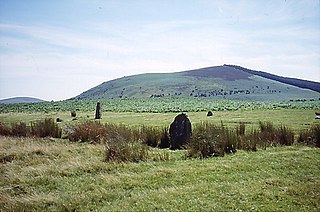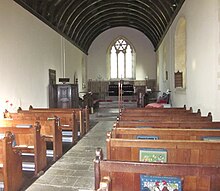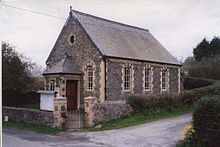
Llanidloes is a town and community on the A470 and B4518 roads in Powys, within the historic county boundaries of Montgomeryshire, Wales. The population in 2011 was 2,929, of whom 15% could speak Welsh. It is the third largest settlement in Montgomeryshire, after Newtown and Welshpool.

Montgomery is a town and community in Powys, Wales. It is the traditional county town of the historic county of Montgomeryshire to which it gives its name and is within the Welsh Marches border area. The town centre lies about 1 mile (1.6 km) west of the England–Wales border. Montgomery Castle was started in 1223 and its parish church in 1227. Other locations in the town include The Old Bell Museum, the Offa's Dyke Path, the Robber's Grave and the town wall. The large Iron Age hill fort of Ffridd Faldwyn is sited northwest of the town and west of the Castle.

Llanymynech is a village and former civil parish straddling the border between Montgomeryshire/Powys, Wales, and Shropshire, England, about 9 miles (14 km) north of the Welsh town of Welshpool. The name is Welsh for "Church of the Monks". The village is on the banks of the River Vyrnwy, and the Montgomery Canal passes through it.

Priestweston is a small village in the civil parish of Chirbury with Brompton, Shropshire, England, lying in the Welsh Marches. Its name is based on the Old English for "western settlement (tun)", with the affix priest in reference to the estate of the Prior of Chirbury at Weston Parva. It was mentioned in Domesday, and later became part of the possessions of the Botterell family.

Corndon Hill is a hill in Powys, Mid Wales, whose isolated summit rises to 513.6 metres (1,685 ft) above sea level. It has a topographic prominence of 203.1 metres (666 ft), so is listed as a Marilyn.

Churchstoke or Church Stoke is a village, community and electoral ward in Montgomeryshire, Powys, Wales. Located in the southeast of the Vale of Montgomery, it is overlooked by Todleth Hill, Roundton Hill and Corndon Hill. The rivers Caebitra and Camlad have their confluence just outside the village. The nearest town is Montgomery. In the 2011 census the village had a population of 708.

Llansilin is a village and local government community in Montgomeryshire, Powys, Wales, 5 miles (8 km) west of Oswestry. The community, which includes Llansilin village, a large rural area and the hamlets of Moelfre and Rhiwlas as well as the remote parish of Llangadwaladr, had a population of 648 at the 2001 census, increasing to 698 at the 2011 Census. There is also an electoral ward including the nearby village of Llanrhaeadr-ym-Mochnant with a population of 2,295.

Llanfyllin is a market town and community in Powys, Wales. The town population in 2021 was 1,586 and the town's name means church or parish (llan) of St Myllin. The community includes the settlements of Bodfach, Ty Crwyn, Abernaint and several farms.
Beguildy is a village and community in Powys, Wales.

Dolanog or Pont Dolanog is an ecclesiastical parish or chapelry that was formed in October 1856. It comprises the townships of Dolwar in Llanfihangel portions of Coedtalog in Llanerfyl, Cynhinfa in Llangyniew and Gwaunynog in Llanfair Caereinion. The total area of this parish is 3,100 acres. Dolanog was within the historic county of Montgomeryshire, which now forms part of Powys, Wales. Dolwar Fechan in Dolanog was the home Ann Griffiths, the Methodist hymn writer.

Bacheldre is a small settlement in Powys, Wales. It is near the A489 road and is 5 kilometres (3 mi) southeast of the town of Montgomery.

Joseph Bromfield (1744–1824) was a notable English plasterer and architect working in the West Midlands and in Central and Northern Wales in the late Georgian period. He was Mayor of Shrewsbury in 1809.
Poundley and Walker or John Wilkes Poundley and David Walker were a land surveyors and architects’ partnership with offices at Black Hall, Kerry, Montgomeryshire and at Unity Buildings, 22 Lord Street, Liverpool. The partnership was established probably in the mid-1850s and was dissolved in June 1867. The partnership was involved with large country estate building projects, church and civic buildings and some civil engineering. They specialized in building model farms. J. W. Poundley was also the county surveyor for Montgomeryshire from 1861–1872. The architect, canal and railway engineer, T. G. Newnham appears have been associated with the partnership.

Trelystan is a remote parish and township on the border of the historic county of Montgomeryshire with Shropshire. Trelystan now forms part of the community of Forden, Leighton and Trelystan in Powys. Trelystan was a chapel of ease within the parish of Worthen and it also served the township of Leighton. In some old sources the parish is also referred to as Wolston Mynd.

St Beuno’s Church is the parish church of Berriew, in the historic county of Montgomeryshire, now Powys. The church stands in an almost oval churchyard in the centre of the village. The original church was a single-chamber, with a wooden west bellcote and a northchancel chapel. This church was replaced in 1803-4 with a larger brick church by the architect John Hiram Haycock of Shrewsbury. It was of brick with stone dressings, and had the entry under a pinnacled west tower to a galleried nave with four round-headed windows a side. The church was largely rebuilt by his grandson, Edward Haycock, Junior in 1876. It consists of a nave, aisles, chancel, north porch, and west tower The west tower has the doorway blocked, stone facing for brick, and Gothic windows, except for the circular ones on its second stage.

Penstrowed is a historic Montgomeryshire parish to the west of Newtown, now in the community of Mochdre with Penstrowed, Powys, Wales.
Trewern Hall or Trewern Farmhouse is a country house in Montgomeryshire, Wales, close to the Shropshire border. It is on a spur in the floodplain of the River Severn, in the Trewern community area of what is now Powys, to the north of the A458 road from Shrewsbury to Welshpool. It is a fine example of a Severn valley half-timbered house. The Grade II* listed hall was occupied by the Lloyd, Francis and Whittaker families. In 1985–86 and 1993–94 it was extensively restored with some remodelling by the architect M. J. Garner for Murray Ll. Chapman.

St Michael's Church is the parish church of Kerry, in the historic county of Montgomeryshire, now Powys. Kerry is sited about 3 miles to the S E of Newtown. which suggests that there may have been a church on the site since the 7th century. The church stands in an almost oval churchyard in the centre of the village. It was rebuilt and re-dedicated in 1176. Of the original church only the north aisle arcade survives, and the chancel arcade is 14th-century in date. The square stone tower is surmounted by a Montgomeryshire style timber-framed belfry. The main body of the church was rebuilt in 1882–83 by the architect George Edmund Street, paid for by James Walton of Dolforgan Hall.

The Lack is a Grade II* listed building, formerly in the historic parish of Churchstoke but now in the parish of Chirbury with Brompton in Shropshire. It is likely to have been built in the latter part of the 16th century.

St Nicholas's Church, formerly called St Mary's Church until 1881, is a Church of England parish church in Church Stoke, Powys, Wales. The church's current building is largely the result of 19th-century reconstruction, but it retains its 13th-century tower with a later timber belfry. From the period prior to the 19th century, only a font, a stoup and a chest have survived up to three phases of restoration and reconstruction. The main body of the church with its large high pitched roof dates to the second half of the 19th century. It is a Grade II listed building.



























